This lovely camera came to me via a friend of a friend of a friend via Twitter. The lady I purchased it from was downsizing and moving house. It belonged to her late husband, who had seen it in Sicily when working on a documentary as a cameraman. He bought it and shipped it back to the UK. How it got to Italy in the first place, I have no idea.
(Edit:07/11/2020 The camera was bought from the Father of the artist that was being filmed in Sicily for a documentary. The artist was John Picking and the documentary was Il Nostro John Picking, filmed in 1981. The artists parents actually lived in Wigan, less than 10 miles from me. They were being filmed as part of the documentary and the cameraman saw the Jerome Ltd camera at the family home and then enquired to purchase it.
A small world, Steph is Curator of the Manchester School of Art Special Collections, and they have some of Pickings work in their collection, as he taught there when it was a Polytechnic. I wonder if he recalls how his Father came to own it??)
From the email images I had seen I thought it might be a Carte de Visite camera of some sort. I hadn’t seen the makers name plate on the front of the camera and lens. Its a company I hadn’t heard of before, Jerome Ltd.
Most of my photographic interest is from the Victorian period, so Jerome Ltd was a new one on me. I can find no other web content in relation to specific cameras but there are two excellent websites with plenty of info on Jerome Ltd, here and here.
This camera set up being pretty identical to the one described by Geoff Welding in the above linked website. Its well worth a read. Wether these cameras were made specifically for Jerome Ltd I do not know, or they have been recomissioned from older studio equipment.
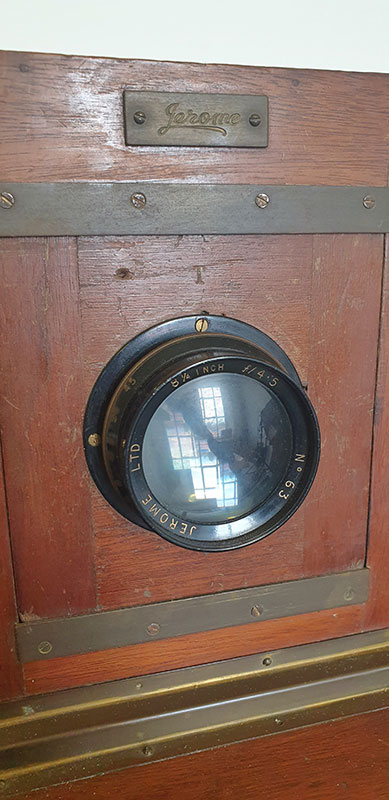
The attached lens is also branded Jerome Ltd and came with an additional front element set numbered No.12, the one on the camera is numbered No.63, I have no idea what these numbers relate to? They are the same focal length and aperture.
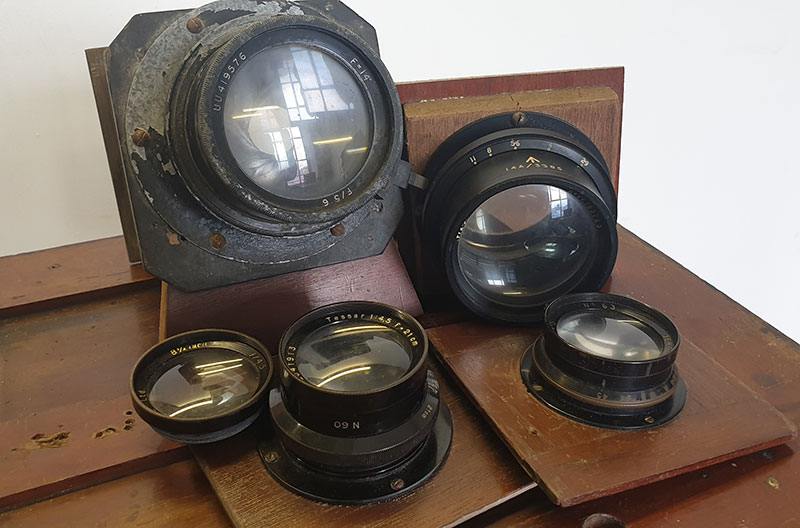
There were also a number of other lenses, mostly Air Ministry 21cm, 14 inch and an 8.5 inch f2.9 which is usually described as manufactured by Dallmeyer or Ross. They are all pretty grubby and the glass will need a good clean. The larger one having a wooden lens extension/support which sits neatly on the camera baseboard.
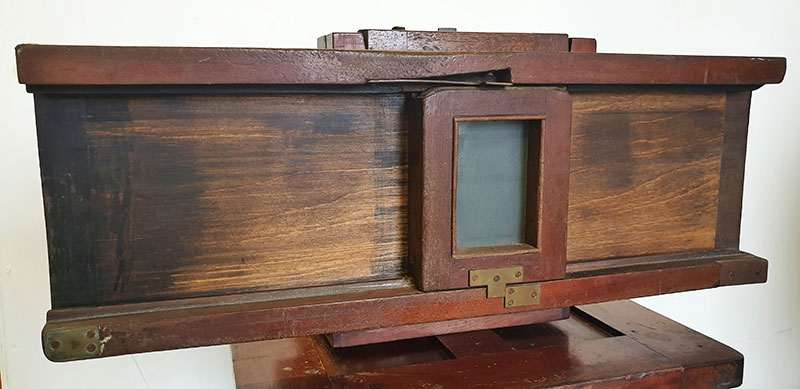
The sliding back mechanism and ground glass, measuring around 2×4 inches (I forgot to measure it oops). The back also rotates to landscape format. The whole rear section can be removed and replaced with a makeshift quarter plate back that also came with the kit.
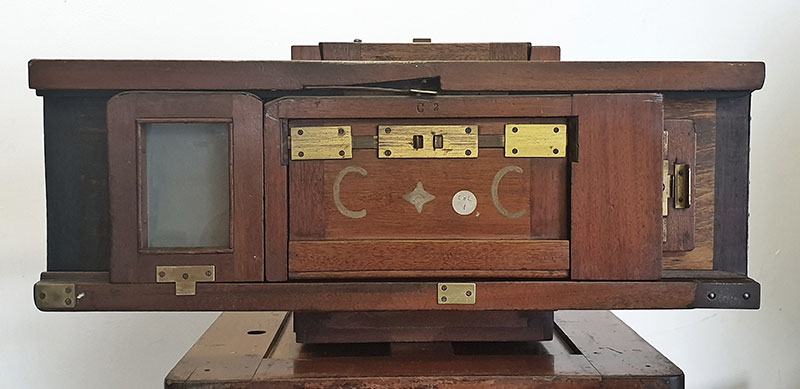
Of the six plate holders, four are split into three portrait slots. With paper/film negative holders to the fold down door. The locking mechanism allows for the frame to be slid along for each portrait. The linked webpage mentions Ilford Paper Negatives and the use of a Reflecitve Enlarger used by Jerome Ltd. I suppose that means people could not print and enlarge their own images at home and had to pay Jerome for copies. Clever idea. If anybody knows any more about reflective enlargement from paper negatives, please let me know.
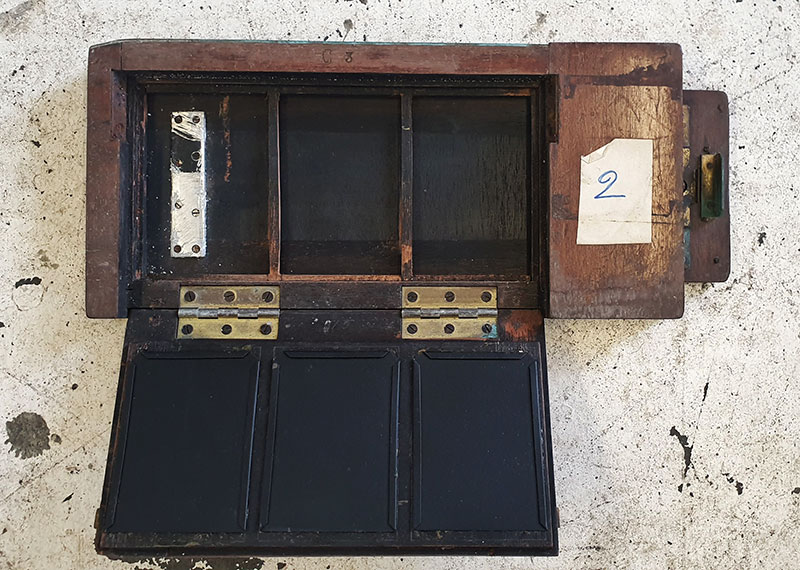
Two of the plate holders have no portrait segments, so just one long panoramic plate. Although the camera inner back only has a hole cut in its woodwork for the smaller image format. Here you can see the three portrait set up with the insert/adapters.
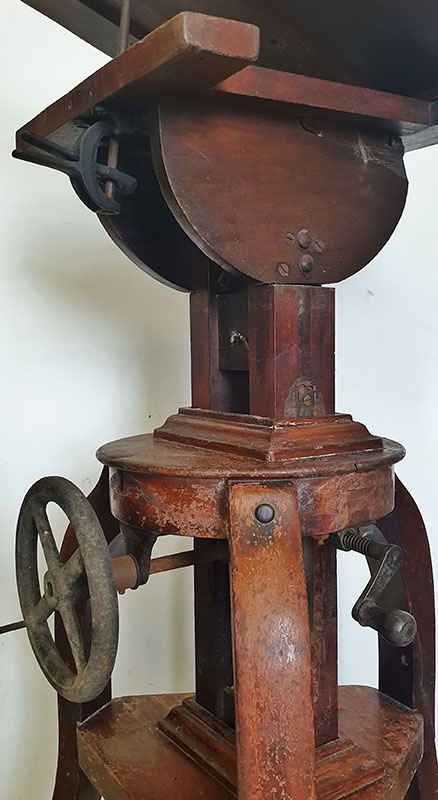
The studio stand is pretty bashed up, and has been adapted over the years but remains very solid. This one has been raised onto a base with casters. It also has an additional central column locking mechanism which isn’t present on my other studio camera stands. Again this needs a good scrub and polish.
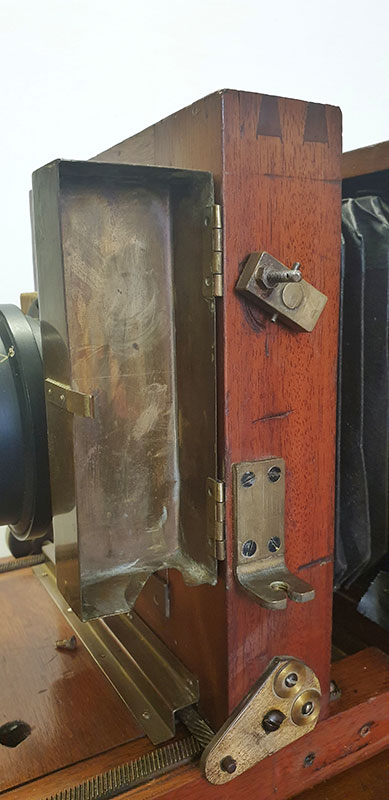
I hadn’t noticed the brass box on the left side of the front standard. On opening, there is a shutter trigger connected to a sprung flap shutter directly behind the lens, so within the bellows. It operates with a very definite “thud”. I will have to rig something up to make use of it. It operates on a pull motion rather than a push, as used by most cable releases. Anyone seen this before? There is mention of a bicycle brake lever and cable being used in the past, which would have the correct movents.

Now all cleaned up, the bellows have been patched for now, as I’ll have to wait to purchase a replacement. It is a lovely addition to the studio.
Edit: Since posting this blog to social media, Facebook friend Bill Spears in Cornwall, UK replied with…
“OMG…. Literally just picked up one of these a couple of days ago ! Exactly the same camera ! with a Jerome lens and the divided backs. Never seen anything like it previously and was really intrigued.“
His camera is almost identical. Even all the dust. His came with two plate holders and a Jerome lens but his is numbered 77.
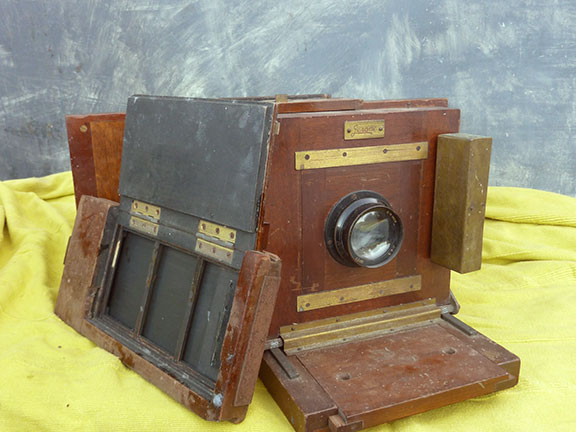
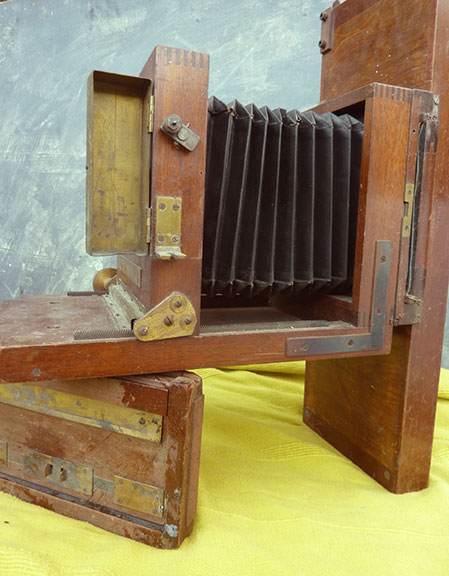
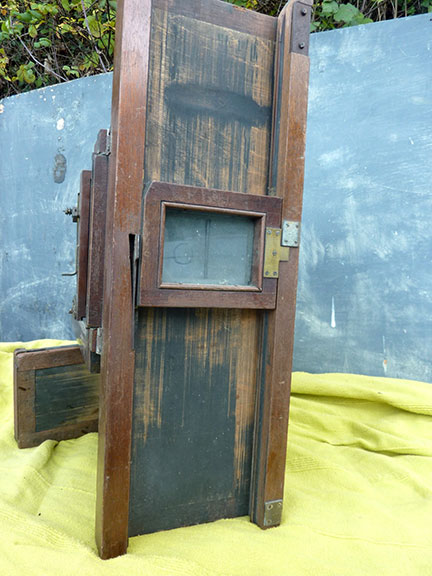
Thanks for the images Bill.
I’m now 88 yrs old and my memory isn’t what it was but I can tell you that I worked for Jerome for about two years from 1958 to 1960. For eighteen months of which I managed the Derby brach. I also worked at the Seven Sisters Road, London, the Kilburn High Rd and the Leicester branches. The camera at all those branches took a paper negative on which three portraits could be taken by moving the negative carrier along. And they were printed by reflex enlargers. The paper negative being placed at the top and the lens and lighti source lower down facing up. The enlarger head did not move but there were shelves below that held the paper which moved up and down spending what size print was required. After fairly conventional processing the prints were then dried using a large revolving drum that was heated inside by gas. It was all very Heath Robinson but worked very well. I hope you find this of interest.
Hello Cliff,
Thank you very much for the info, always of great interest. I’ve kept this camera in my collection.
Thank you
Tony
Hi Tony,
I’m glad my tale was of interest. It’s great that you kept the camera but you must have a big house because they were big cameras.
The man I first worked for in photography was called Philip Gotlop (look him up). Some of his cameras were even bigger. One of them used 12in x 10in plates. This was in Kensington Church Street in 1956-58
Hi Cliff, I’ve downsized from my largest, which was 16x20inch. My largest is now only 12×16 inch. So the Jerome is relatively small 🙂
Wow.so very interesting, I worked at The Kilburn branch of Jerome’s in the 1960 s
I started work I’m reception ,then was trained up as photographic operator by Mrs Vivienne Gilbert,the Receptio manageress was a lady named Mrs Kerr
I worked alongside Angela Hemmington
In the workroom Miss Tanglen retouched the paper negs
The printer was a Mr Long who ever day would take two sausage rolls and Two jam doughnuts ,a large mug of
tea and smoke a woodbine whilst reading his paper
I loved those days.I did some modelling for them advertising,new techniques and other things but my love was in taking the photos even though I was sent to Cranbourn street for a screen test
After marrying and having a family I went int social work,
However to this day I see life from a photographic lense
Strangely enough many years later I met a wonderful man called Frank Long,my second marriage brought joy as do my amazing children all duly photographed
I also remember working with quite an elderly lady called Miss Bird
Seeing the wonderfully images of cameras I worked with brought back so many happy memories
I often wonder what happened to all of the lovely people I worked with.
I am fast approaching my 80 th Birthday so sadly many would have passed
I still have some lovely Jerome photographs ,and considering the advance in this avenue good old Jerome’s did a good job